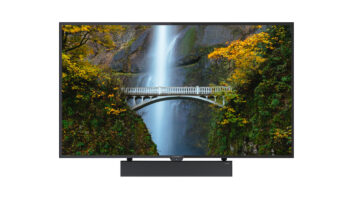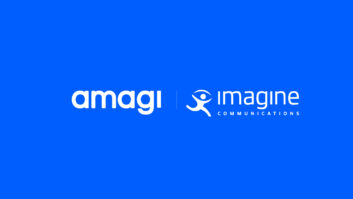Toshiba looks at 1995 as a “good news/bad news” year for the color television industry, with the company revising its forecasts for most categories to show unit volume and pricing declines from 1994’s record-setting performance.
Steve Nickerson, Toshiba color TV, VCR and DVD VP, said weaker demand will result in a 3% drop in overall color TV volume to 26.8 million units, while pricing will dip an average of 15%.
“The good news is it will be the second biggest year for units in history, the bad news is that 1994 was the best year ever, with 27.7 million units,” he said at a recent industry press gathering in New York.
Compounding the problem is the consistently high level of price erosion, while the mix shift to larger screen direct-view models has been somewhat offset by stronger than expected demand for 31″ and 32″ models (nine weeks of inventory) than for 35″ sets (21 weeks of inventory).
“Price erosion is a way of life,” Nickerson stated. “So, in an industry where units are only down 3%, people that are managing businesses in this area have to figure out how to manage their business with 15% to 20% less dollars than last year. That is something that the industry, individually and collectively, needs to look at.”
Nickerson called upon industry market share leaders to act more responsibly in pricing policies and promotional activities, and, he added, all manufacturers must adjust production levels to match economic realities.
“The responsibility here as an industry really falls on the leaders. There are a lot of manufacturers who like to say they are market leaders. A lot of unit sales do not make you a market leader. How you lead the market makes you a market leader,” he said. “If you lead the market down, that is not a positive: You lead the market down only to protect your own individual interests.”
The big-screen direct-view category will see a 30% increase in unit sales, Nickerson said, and “based on the latest numbers, it will probably fall somewhere around 1.97 million units.”
“The bad news is that retail pricing during the third quarter last year versus this year is down about 15%,” he added. “While the units are up 30%, all these retailers are looking at maybe single-digit or low-digit dollar increases.”
Nickerson called projection TV “the one good-news area without really any bad news.” He expects the category to exceed 800,000 units, up 34% on a unit basis.
Unlike direct view, the projection category is still having “a huge shift, so average unit sales are actually up in projection TV, as far as dollars. The below-50″ segment is only growing by about 20%, and 50″-and-above is growing by almost 43% so far this year,” he said, noting that Toshiba’s market share in the category will top 10%.
Unfortunately, the worst news comes from the 27″-and-below business, which will see “the lowest level since 1992,” according to Nickerson. The portable business will move 21.5 million units, down 7% from 1994, and “every screen size except for 27″ will probably be flat or down this year.”
The biggest reduction will come in the 20″ segment, he said, noting that when customers step up in portable they are moving up in screen size rather than moving within screen sizes, forcing 80% of the business into the midprice points.
The good news in the TV/VCR combo business, said Nickerson, is that “we are moving screen sizes up. There is 27″ and 25″ product out there. The bad news is that unit sales are up only about 6.5% and probably won’t fall above single digits before the end of the year — that is a first.”
The combo category will expand to include players other than VHS decks in the next two years, he predicted. “I think you will see DSS product that will be more in tune with bigger screen product. I think you will see SD-type [Super Density] product in bigger screen units.”
“Combo SD probably won’t be introduced at the same time as the first decks,” Nickerson added, noting that the new DVD agreement with the Philips-Sony camp has disrupted original marketing schedules.
Although he thinks that SD/TV combo product “is an easier type of product to bring to market with a single format than it would have been had there been competing formats, it is pretty much out of the question for next fall.”
Philips, Live E. Video CD Movie Titles On Way
On the heels of announcements of a new cooperative effort to develop a single Digital Video Disc standard, Philips Media and Live Entertainment said they would be releasing a variety of new feature film titles in the already established MPEG-1 Video CD format.
The films, including the popular adventure film Total Recall set to retail for $30, represent the first in a new series of Video CD titles to be released through the agreement. Future joint Video CD releases will include the Rambo series, The Crying Game, Reservoir Dogs, Basic Instinct, Dirty Dancing, On Golden Pond and Terminator 2.
The release is viewed by industry observers as adding a value enhancement to the Philips Compact Disc Interactive (CD-i) system amid aggressive competitive challenges from manufacturers of other video game platforms.
In related news, Yashica has joined the ranks of CD-i player manufacturers and is marketing a high-end portable player for the industrial market. The unit, described as “an interactive communications tool” in company releases, is said to offer more efficient means of employee training.
To facilitate such applications, Yashica is also marketing a software program called CD-i Solutions that is said to reduce the cost of producing a CD-i program to as low as $500. The cost of the software and player is said to be under $1,500.
DirecTv Offers Subscription Commissions
DirecTv said it is offering consumer electronics retailers a new commission program, designed to create long-term profit potential for programming sales.
The incentive program, which is similar to one announced to satellite dealers in August, will give retailers “the potential to earn commissions on every DirecTv programming subscription for as long as the account is active,” the El Segundo, Calif.-based company said.
Authorized retailers who sign up for the performance-based program will be eligible to earn commissions on activations after October 1.
Elsewhere on the DBS front, PanAmSat said it may enter the already crowded direct-to-home satellite market in early 1997 by offering a package of Spanish-language programming to households in the southern United States. The service would be an outgrowth of programming primarily targeting the Latin American markets on PanAmSat’s Galavision DTH system.
States in the southern portions of the country fall within the footprint of PanAmSat’s bird, which will be used for the service, said a PanAmSat spokesman. Territories in Latin America are scheduled to receive that service next spring.
PanAmSat is still putting together marketing plans and has not determined how receivers will be sold in the United States, Marcus said. However, the company has formed a partnership with Mexico’s Televisa to distribute product south of the border. Once the whole system is rolled out, PanAmSat expects to offer 120 digital channels of programming for the U.S. package.
Clarification:
Thomson and USSB are also parties, with DirecTv to the agreement allowing SW Bell to market DSS hardware.













